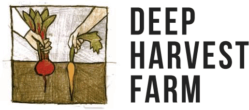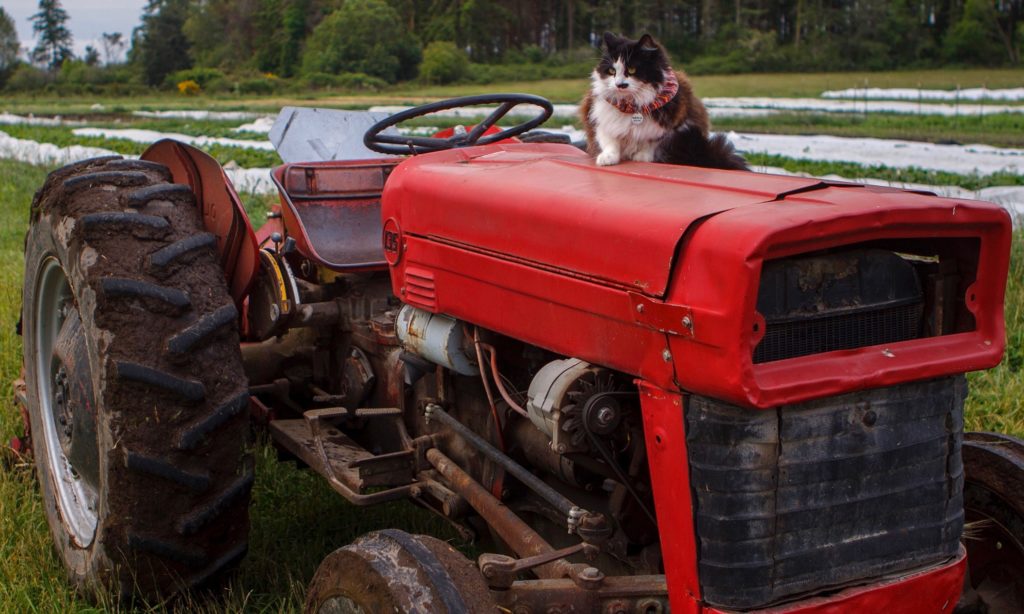 There are a couple distinct ways of approaching one’s small farm business. One approach is to buy all the snazzy equipment right away and assume it will eventually pay for itself in saved labor. Of course this doesn’t always pan out. Some examples of such luxurious small farm tools include new tractors and tillers, snazzy flail mowers and finger weeder implements, paperpot seeders for the fields (look it up, they’re trending on small farms), the vacuum seeder for the propagation house (also fun to google), and the greens harvester to cut salad without bending over (yet again, mr. internet will answer your questions), etc. to infinity and beyond. I don’t know if you know this about us, but we are not those kind of farmers. We are proudly scrappy, making sure a new tool is beyond well-earned before making an investment. After digging over 5,000 feet of potatoes in our first seven years, we decided we’d earned a potato digger. (Could’ve made that minor purchase a couple of years sooner to save the ol backaroo!) After 9 years on a tractor from the 60s and saving up our parsnip pennies, we figured we were due for a tractor with 4WD and some legit horse power. Mighty helpful when driving around in soggy springs! Twelve years in, we deemed ourselves worthy of a grown-up propagation house for our plant babies rather than two hilariously cramped, gardener sized start houses. Until we know for sure a farm addition is really, definitely going to improve efficiency and financially payoff, we hold off. So out we go to the fields to transplant by hand, knowing it’s the right move, at least for us.
There are a couple distinct ways of approaching one’s small farm business. One approach is to buy all the snazzy equipment right away and assume it will eventually pay for itself in saved labor. Of course this doesn’t always pan out. Some examples of such luxurious small farm tools include new tractors and tillers, snazzy flail mowers and finger weeder implements, paperpot seeders for the fields (look it up, they’re trending on small farms), the vacuum seeder for the propagation house (also fun to google), and the greens harvester to cut salad without bending over (yet again, mr. internet will answer your questions), etc. to infinity and beyond. I don’t know if you know this about us, but we are not those kind of farmers. We are proudly scrappy, making sure a new tool is beyond well-earned before making an investment. After digging over 5,000 feet of potatoes in our first seven years, we decided we’d earned a potato digger. (Could’ve made that minor purchase a couple of years sooner to save the ol backaroo!) After 9 years on a tractor from the 60s and saving up our parsnip pennies, we figured we were due for a tractor with 4WD and some legit horse power. Mighty helpful when driving around in soggy springs! Twelve years in, we deemed ourselves worthy of a grown-up propagation house for our plant babies rather than two hilariously cramped, gardener sized start houses. Until we know for sure a farm addition is really, definitely going to improve efficiency and financially payoff, we hold off. So out we go to the fields to transplant by hand, knowing it’s the right move, at least for us.
Author: Deep Harvest Farm
Reduced Tillage Musings
The quest to reduce tillage, reduce inputs and ultimately, reduce work, continues….
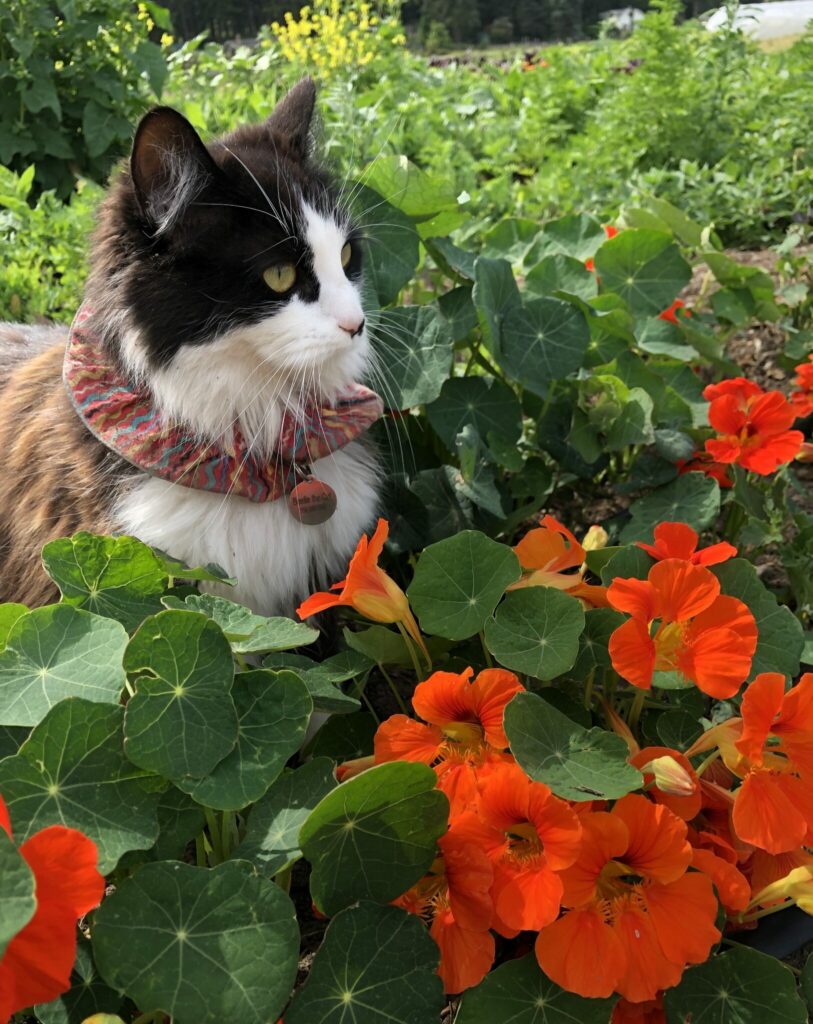
Our soil management regime currently centers around planting annual cover crops in the fall. Usually this is a mix of a legumes and grasses which grow a bit in late Sept/Oct., rest through the cold, dark of winter and surge into growth in spring. They often reach 6 feet tall by May when they flower and become fibrous/carbonaceous.
Working material back into the soil so we can run a seeder through the dirt again is a big process. This entails grazing sheep, flail mowing, tilling, chisel plowing, perhaps tarping, tilling again, maybe raking or some combination. At minimum it’s a 6 week process that requires no less that 4 passes with the tractor per bed. It’s a ton of labor, fuel, and tractor wear and tear, but the worst is the amount of soil damage incurred in the process.
It’s a constant dance of building and destroying soil health, just to maintain status quo. I’m always scheming about how to streamline this process, or otherwise change it up without sacrificing the benefits gained from the cover crops (which are vast). One option is buying compost to maintain organic matter instead of growing cover crops, which doesn’t require mowing and tilling to incorporate. Unfortunately, compost is incredibly expensive to buy and labor intensive to spread. It also doesn’t capture carbon, prevent erosion, maintain soil biology (the rhizosphere of cover crops keeps the soil ecosystem happy through the winter) or suppress weed growth like cover crops do.
One interesting soil management strategy we’ll test next season is the use of live pathways. First we’ll seed a field of, say, red clover in the fall and let it grow until the following spring. Then, we’ll mow the field and strip-till 4-ft wide beds every 7 feet, leaving permanent 3 ft-wide clover pathways between the beds. This field layout could theoretically last for years and hopefully won’t require planting and tilling of cover crop every season. The 4 ft beds will be fertilized, planted, and weeded like normal and then mowed after the crop is harvested. We’ll manage pathways with a 3 ft riding lawnmower which will shoot clover clippings out the side into the bed as a nitrogen-rich mulch. The following spring the bed will hopefully be re-established with a single pass with the rototiller.
Granted, I can foresee a millions ways things could go awry, but hey, it sounds cool on paper. We’ll try to keep you posted on results!
Farm Diseases and Critter Pests
Here’s part 2 of our Farm Foes series. This week it’s diseases and critters!DISEASES:
- Downy Mildew – Wondering why the onions are so small this year? Blame the mildew, which killed their leaves before the onions had a change to swell up. Luckily small is still yummy. It also our afflicts our Russian kales in the late summer and fall.
- Sclerotinia – A fungus that affects the roots and stems of lettuce-family seed crops, including sunflowers. We lost a couple lettuce crops to the fungus this year.
- Late Blight – We haven’t seen any this year, thank goodness, but when it does rear its head you can say goodbye to all the tomatoes. We’ve only had a couple years when it’s been a major problem. Growing under tunnels and greenhouses generally keep the tomatoes dry and fungus-free.
- Powdery Mildew – Not a serious disease, but a life-shortener of chard, zucchini and cucumbers. Good riddance. Who wants to pick those plants for months on end anyway.
- I can’t think of any more economically significant diseases, which is pretty great!
OTHER CRITTERS:
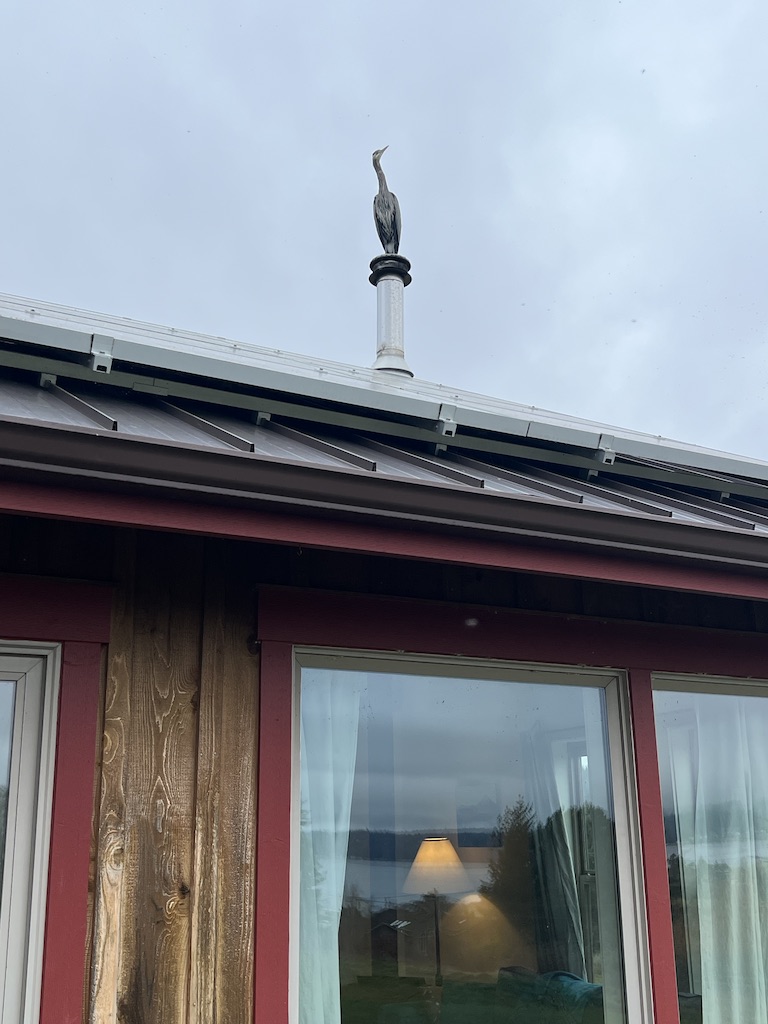
- Birds! – We love em, but they’d completely annihilate many of our seed crops without bird netting. Finches are the worst for small seeded things (brassicas, cosmos, spinach), and blackbirds for larger seeds (sunflowers, corn).
- Slugs – We all know what slugs do. I think 20% of our farm budget went to Sluggo during that endless wet spring of 2022. Unfortunately, our ecological management practices like cover cropping and maintaining undisturbed perennial zones also create ample slug habitat.
- Voles – Come fall, these critters get audacious and develop a particular taste for carrots, beets and radishes.
- Deer – They can’t do too much damage on the vegetables, but can wreak havoc overnight on our little fruit trees if we leave the gate open.
- Coyotes – We’ve lost a chicken or two or thirteen to these wily beasts.
Farm Weeds
It’s breathtaking: the naturally occurring biodiversity that magically appears to stake its claim on one’s organic field. Dozens of weed species, insect pests, and countess bacterial, viral and fungal diseases. Not to mention the vertebrates, which can’t be underestimated. These species put the ‘work’ in farming and keep us permanently on our toes. Here’s the first in a two-part series on the top tier nemeses that make their way into our daily farm lives. This week: Weeds! Next week: Diseases and Beyond!!! It’s a whimsical balance between letting all these scrappy cohabitants have their lunch and allowing us to make some cash.
WEEDS:
1. Hairy nightshade – Our most prolific and aggressive summer weed. Fast growing with a
strong root system, forming hundreds of small green berries packed with seeds.
2. Lambs quarter – A nutrient rich relative of spinach and quinoa, it’s our fastest growing weed and a producer of thousands of minuscule seeds per plant.
3. Canada Thistle – Our most existentially threatening weed. Thistle forms aggressive horizontal roots systems that are aggravated and spread from digging and tillage. In a pasture it may be managed by repeatedly mowing, but in annually worked vegetable fields there are no real organically-certified suppression methods. We tried tarping, digging, burning and an organic herbicide, which it all laughed off. Thus, we had to take one of our fields out of organic certification (and production) for the three years to spray a patch. It blows in every year from neighbors’ fields, and without a well-funded, county-wide management the problem with continue to worsen.
4. Field Bindweed – While this isn’t widespread on the farm, it has cropped up in a few locations and is spreading like wildfire. Like, thistle it forms spreading roots systems that we can’t figure out how to kill with organic methods. Unfortunately, we’re going to have to pull out two new beds of strawberries, because it has spread aggressively under the black plastic. We’ll put this area into pasture for a few years and mow it like crazy in an effort to wear this plant out.
5. Chickweed – Our most serious cool-season weed, but not a huge nuisance. Once the fall crops mature, we let chickweed run rampant, as it doesn’t compete with the crops at that point and acts as a makeshift cover crop. It can be a pain though during our super long, wet springs.
Small Farm Tractor Implement Talk
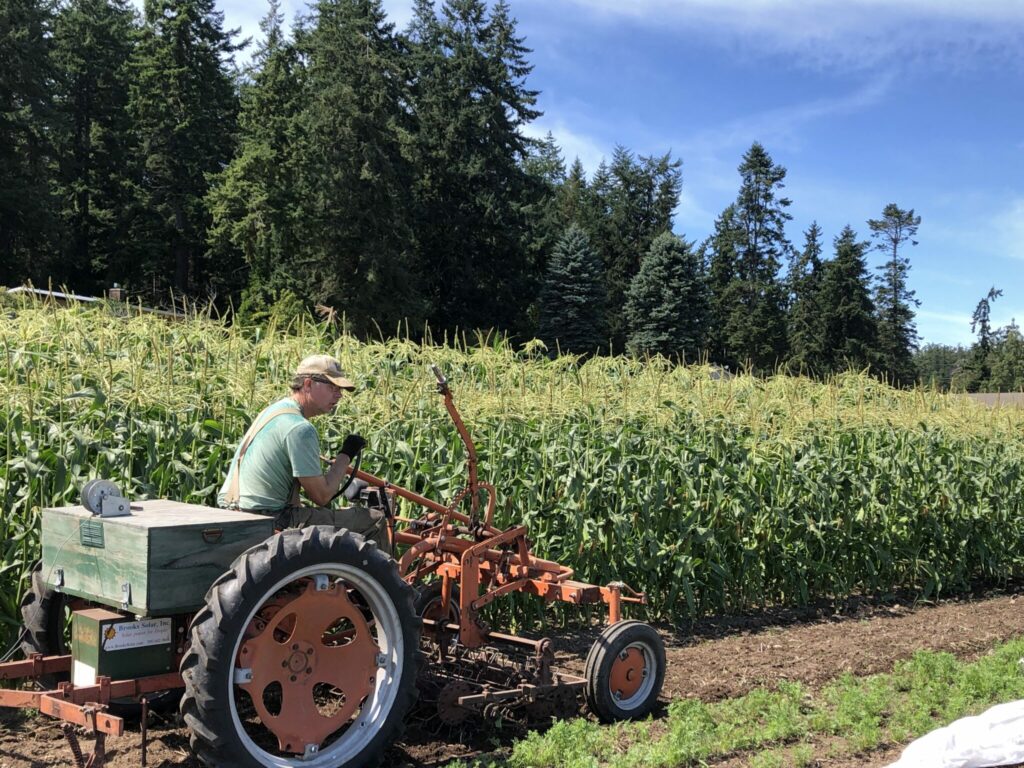
Wondering what kind of fancy tractor implements we use on this little organic farm? I know you are. The curiosity has likely been eating away at you all year, so apologies for not getting around to the subject sooner. While most small farms rely heavily on hand labor for harvesting, weeding, trellising, etc. having a tractor is pretty nice for moving dirt around without throwing your back out. Very small farms, generally under a couple acres, often rely on 2-wheel tractors like a BCS or other model, for tilling, plowing or harrowing small areas. We also use a 2-wheel tiller for getting inside tight spaces like greenhouses and tunnels, but mainly we use our 45 HP Branson tractor for tillage type of work.
The main implements for the Branson tractor are as follows:
Flail Mower – Chops up cover crops and cash crops into small pieces for quick breakdown into the soil.
Brush Hog – Faster and coarser than the flail. Good for mowing large areas of grass.
Chisel Plow – 2’ deep, 18” shanks that break up compaction and help aerate subsoil.
Rototiller – Used shallowly to incorporate weeds, cover crop, or vegetable residue into the soil. Also the final step in bed preparation to create a nice soil texture for seeding.
Cone Spreader – Spreads fertilizer (lime, feather meal, dolapril, etc.) evenly over a 30 ft width. Holds 400lbs of fertilizer per load.
Middle Buster – A big shovel like tool that is dragged to create trenches for potato planting. Also doubles as a potato harvester!
We also have a 15HP electric cultivating tractor that we drive over young crops to weed between rows. Gotta plant in straight, parallel rows for it to work!
We’re always geeking out on new tools to possibly add to the arsenal, but equipment is expensive and usually doesn’t pay off unless it’s a great fit for your farm system. We’re eyeing a Power Harrow for 2024, which is like a fancy rototiller, but creates less soil disturbance and compaction.
Food Preservation in a Hurry
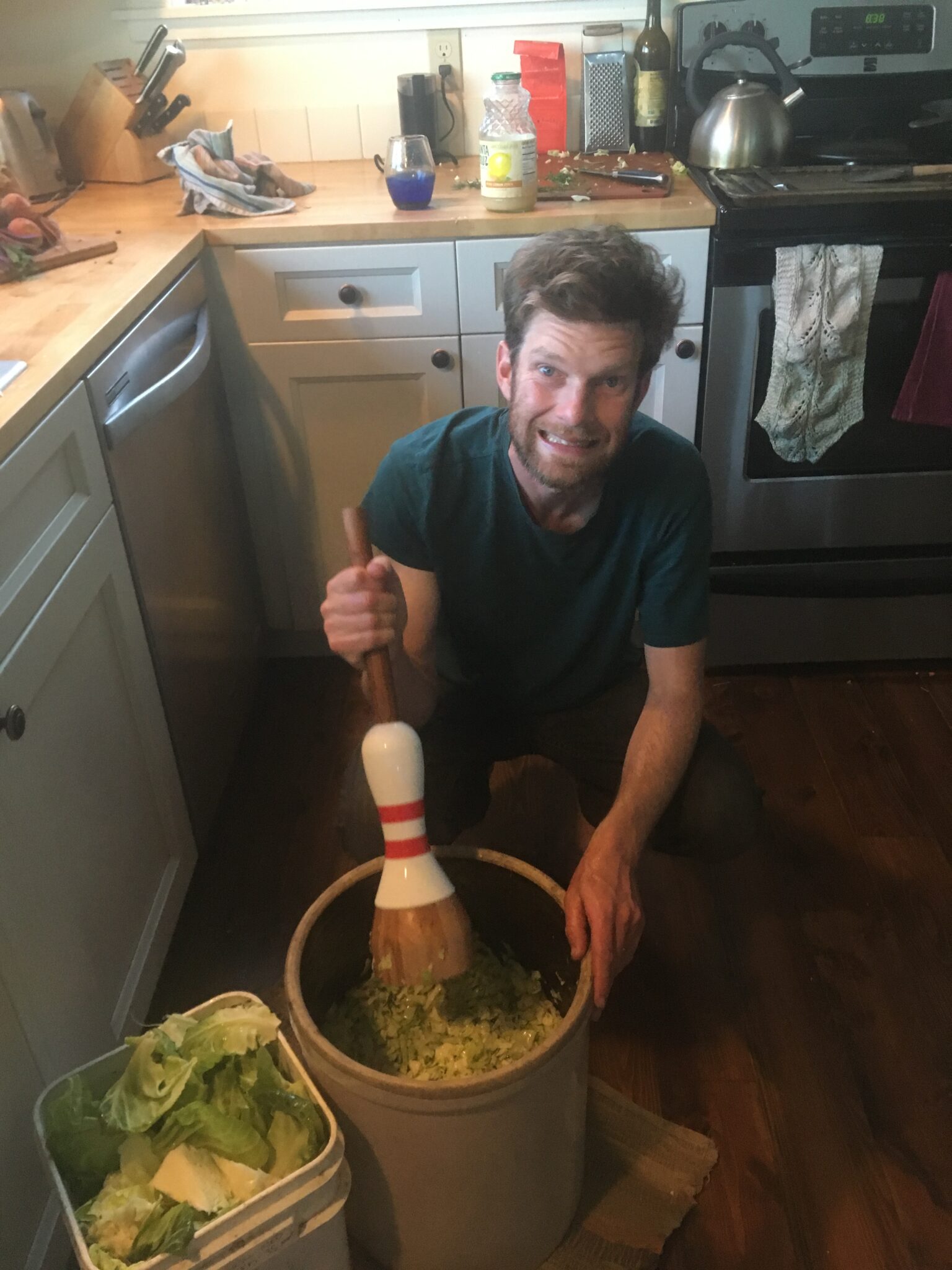
I’m sure I’m not the only one of us who has made it through all of summer only to now notice the pantry is absent of any preserves and the freezer lacks any sign of this year’s harvest. Never fear! Time Constrained Preservation Princess is here (yep, that’s what I’m now going by). Now is as good of time as any to capture the tastes of summer in quart jars and freezer bags. I never do anything too complicated, as time is still limited and precious, but my oh my do I love myself in the winter for doing the deliciously easy stuff now. So… here’s what I prioritize in preservationville (not quite as exciting as Margaritaville, RIP Jimmy Buffet).
Basil
Pesto!! We make boat loads and just freeze it in pint sized freezer jars. No water bath shenanigans, super easy peasy (and basily). I also dehydrate tons of basil and jar it up for future pizzas, soups, pastas and gifts. It’s so much sweeter and more flavorful than the old store stuff.
Tomatoes
Next, we freeze tomatoes whole in ziplock bags, especially cherry tomatoes, but we do this with the big guys, too. You literally don’t have to do anything expect take off their green stems. We pour the frozen flavor bombs into soups and stews come cold season. Boomshakala! I also roast tomatoes whole with a little olive oil and salt until they’re pretty much caramelized. Once cooled, I jar or bag this sludgy bliss and toss that into the freezer for casseroles, pizzas, soups, etc. Lastly, I cook down tomatoes whole with the skins on (most recipes tell you to remove the skins, but I’m not that kind of girl).
I use the immersion blender to break ‘em up if I want sauce and leave some in full tomato form for stewed tomatoes. Once they’re cooked down to my liking, I put the tomatoes in sterilized jars, add 2 TBS of bottled lemon juice per quart, seal it up, and water bath the beauties for 20 minutes. Yes, this is a bit of effort, but for farm fresh, heirloom tomato gloriousness, it’s worth it.
Cabbage
We’re all about making loads kraut, kimchi, curtido, and more kraut. They all maximizes the health benefits of cabbage with all its probiotics that make food more digestible and improves your guts ability to absorb nutrients. Fermented foods are also easy to make. I use the Sandor Katz’s book “Wild Fermentation” for the specifics, but their are oceans of recipes on the ol internet. This is an excellent mode of preserving cabbage and more for 4-6months.
Carrots, Radishes, Cucumbers, Onions, and Garlic
Other than that, I’m pretty into quick pickling carrots, radishes, and cucumbers, dehydrating garlic and onions for garlic and onion powder. I’d love to hear your preservation passions and secrets to keeping the harvest!
Why We Love Being CSA Farmers in the Fall
 Welcome to your life as a Fall CSA member, the club of squash soup supporters, allium enthusiasts, root rooters, and hearty green heart throbs. It’s an eclectic posse of folks we’ve got here, unafraid of fennel and cool with kohlrabi (or so we hope!). The Fall season holds a special place in our woolen hearts. When Nathaniel and I started off as a wee lil farmer lad and lass we thought we may very well be exclusively cold weather growers. The cold season veg market was wide open, the foods were our faves, and it felt thrilling to picture pulling veggies out from under layers of row cover and mulch amidst the whipping winter wind. Some of you were there with us, up at Greenbank Farm where it all began.
Welcome to your life as a Fall CSA member, the club of squash soup supporters, allium enthusiasts, root rooters, and hearty green heart throbs. It’s an eclectic posse of folks we’ve got here, unafraid of fennel and cool with kohlrabi (or so we hope!). The Fall season holds a special place in our woolen hearts. When Nathaniel and I started off as a wee lil farmer lad and lass we thought we may very well be exclusively cold weather growers. The cold season veg market was wide open, the foods were our faves, and it felt thrilling to picture pulling veggies out from under layers of row cover and mulch amidst the whipping winter wind. Some of you were there with us, up at Greenbank Farm where it all began.
Year one, we enjoyed a shockingly mild winter, allowing us to pull off a substantial CSA well into February without really knowing what we were doing. Beginners’ luck for sure! Year two, Mother Nature didn’t hook us up in the same fashion and instead dumped heavy snow for our last share of the season. This shut down the roads to all but four-wheel drive vehicles (which we didn’t have) and public transit. We proudly delivered shares up to the Coupeville Hospital on the bus. A year or so after that, we had to cut our season off a week earlier than expected thanks to a six-day hard frost that killed even our heartiest roots under the thickest winter row cover.
Thus, over the past 12 years running a fall/winter farm share program, we’ve grown cautious about pushing the season late into the year. We’re admittedly also a little soft now that we’re more aged and our backs and hands feel the realities of cold weather. BUT- we are still passionate about farming this time of year! The harvests are so much less hectic without the slow-to-pick summer crops (we’re looking at you beans and zucchini). We don’t need to rush irrigation to and fro. And the crops are all weeded and mature, just hanging out waiting to be picked.
It fills the heart with elation to look around and see 600 cabbages ready to kraut, 800 brussel stalks begging to be roasted, and a whole tunnel of cleaned onions, garlic, squash and shallots aching to be masticated (I know, those guys are odd). We’re breathing easy, sleeping more, and feeling thankful for the cooling weather and shifting day length. Hope you can say the same.
Chicories are Trending
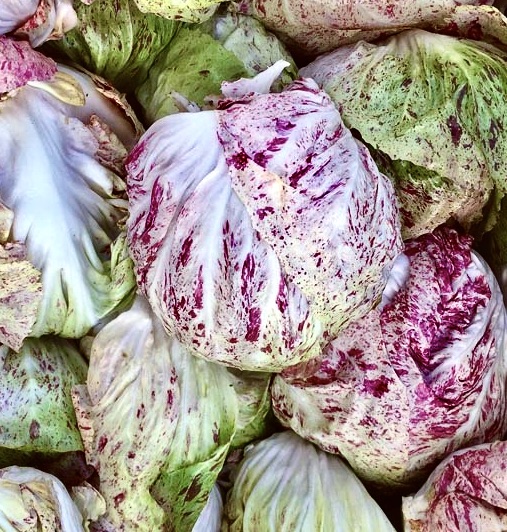 For those of you unacculturated to the wonderful universe that is Chicorylandia, we’re so glad you made it. For you who’ve been here before, welcome back to town. It’s a trendy little locale! A few weeks back, the NYTs even proclaimed chicory is “in season and in style”: https://www.nytimes.com/2023/10/18/t-magazine/radicchio-chicory.html. And it had its very own hipster festival in Seattle: https://www.chicoryweek.com and social media presence #bitterisbetter and @chicoryweek.
For those of you unacculturated to the wonderful universe that is Chicorylandia, we’re so glad you made it. For you who’ve been here before, welcome back to town. It’s a trendy little locale! A few weeks back, the NYTs even proclaimed chicory is “in season and in style”: https://www.nytimes.com/2023/10/18/t-magazine/radicchio-chicory.html. And it had its very own hipster festival in Seattle: https://www.chicoryweek.com and social media presence #bitterisbetter and @chicoryweek.
But what is it? And what’s up with it? Chicories are a passion of these farmers of yours. They’re a big ol beautiful family with origins in Italy. They’re generally slightly bitter (but that doesn’t equal bad!), always leafy, and enjoyable raw or cooked. Frisee (aka curly endive), Belgian endive, escarole, and radicchio are all relatives found in the chicory family tree. If you’d like to eat them raw, a sweet and rich topping is recommended. Apples, pears, citrus, strong cheese, candied nuts, crème fraiche, fried bacon, and warm vinaigrettes are all stellar companions to these beautiful leaves when eaten in salad. If you cook them, the bitterness subsides and a nutty, earthiness shines through. Risottos, soups, and baked pastas are all traditional ways to show your regards to this winter hardy crew. Like I’ve said to our longer term farm share members, you like bitter things! Remember coffee and chocolate??? Don’t deny yourself the beauty and experience that is chicory indulging, just because you aren’t used to bitter in greens. It takes a little time, the right recipes, and an open mind, but you can do it! But if you’re still not convinced, we won’t judge you for eating bok choi this week instead.
The Cyclone that wasn’t
As of right now, it looks like we’ll be just fine for our standard pick-up this week. We, along with the rest of the Northwest were fired up about our first potential harvest in a bomb cyclone, but alas, we bunched carrots in underwhelming 20mph gusts and sideways rain. Catch ya next time, bc! To prepare for the gusty guest that didn’t show, we, along with farmers throughout the PNW took the plastic off all our caterpillar tunnels, which was mighty adult of us, if I do say so myself. Normally, we wait until a windstorm decides to remove half of the plastic for us and then we go join in in a chaotic scene that is hazardous to human safety, but my, is it exhilarating!! We also pre-filled all our washtubs with water so we’d be ready to tidy up your share in a dark, powerless wash station, but that also didn’t need to happen. Lastly, we removed about 20 – 125 foot long sheets of row cover that were protecting our carrots from rust fly and our brassicas from root maggot. We once had a piece of row cover form its own ghostly tornado, take flight, and land in the top of an 80 year old Doug Fir. Not our finest hour. So yah, basically, I’m saying, we, like all of you, made some little preparations and we want a high five for it. Don’t leave us hanging!
Fall Vibes
Fall vibes are cranked to 11. A season’s worth of carbon and solar energy has culminated into a bunch of roundish, delicious things. They’ve been reaped, cleaned and stored for the next several months of photosynthetic downtime. The winter squash is picked and artfully stacked in the greenhouse for curing while the onions and garlic are boxed, labeled and oh so orderly stuffed under our garage ping pong table. Hundreds of pounds and over 80 varieties of seeds are almost completely harvested, threshed, screened, winnowed, dehydrated and tucked into 4 gallon buckets where they may live in our entryway for the next several weeks, and proper storage racks for the next several years, awaiting their shipment to another random plot of dirt in the U.S. Potatoes are being dug and stowed away in garbage bins with a bit of wood shavings.
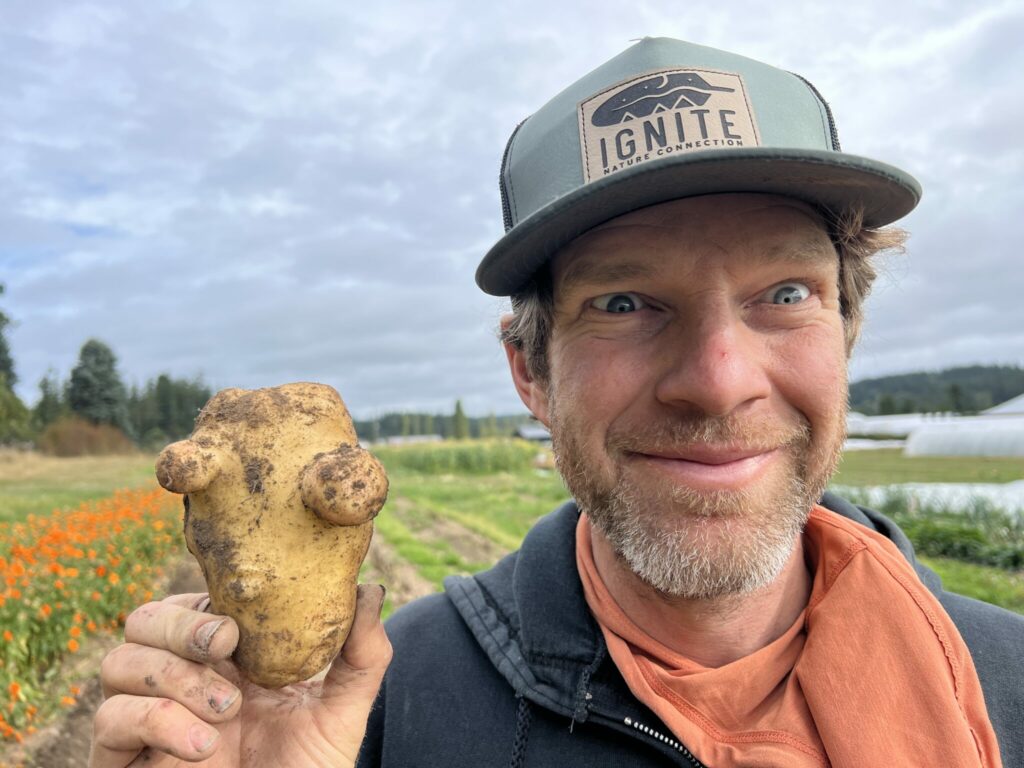
Out in the fields, the fall clover, rye, oats and vetch are coming up thick and green (almost looking like we know what we’re doing after so many years of patchy, mistimed cover crop seedings!). The sheep have moved off their summer veggie/cover crop paddocks onto a longer term winter pasture (our uncultivated back acre) so, as the daylight wanes, the fall cover crops can focus their precious energy toward growing leaves and not wool. Firewood is stacked, greenhouses are clearing out and the last of the hanging apples are quickly succumbing to yellowjackets and their ilk. Back inside, the meals are getting a bit less fruity and a bit more rooty as we revel in the season’s first rutabagas, winter radishes and parsnips. The barn is still a chaotic warzone. If it’s lucky, it may enjoy a few fleeting days of organization sometime in the dead of winter when nobody is around to appreciate it.
